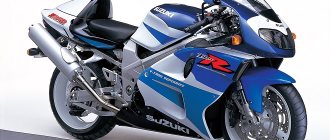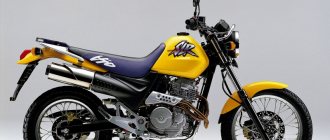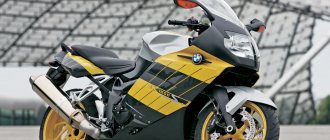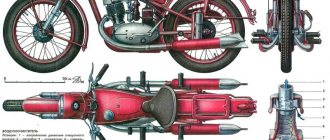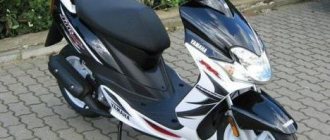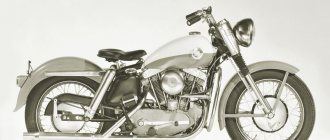Due to the growing popularity of chopper bikes in America, there is a need for new models. This trend was picked up in time by the Japanese brand Suzuki, which began producing the excellent model Suzuki Intruder 400. At first impressions, the motorcycle looks simple and restrained, but Japanese quality and its own technologies once again prove that the new product turned out to be successful.
In general, the first Suzuki Intruder 400 appeared in 1985 with the 750 model. But already in 1994, another new model entered the American and world markets - the Intruder 400 chopper. To this day, the production of the Intruder series motorcycle has not survived, but the models remaining until 2005 are still actively purchased due to their convenience and high performance. Moreover, you can hardly distinguish all the models from the series by their appearance; all Intruders differ only in the engine.
pros
- Branded Japanese quality;
- Excellent top speed;
- Possibility to supply a part from another Intruder;
- High power and appropriate design.
Minuses
- Frequent carburetor breakdowns;
- Poorly designed driver footrests.
The name of the model was not created by chance; Suzuki Intruder 400 is translated as “Invader”. This invader was truly able to conquer the chopper market and become one of the best in its class. When developing the new product, the Japanese did not even think about such success, so the bike must be included in the review.
Invader from the Far East
The word Intruder has no absolute equivalent in Russian. Its approximate meaning is something between “Invader”, “Conqueror”, “Occupier”, “Invader”. Surely, when giving this name, the manufacturer was thinking not only about the shade of aggressiveness that it would give to the image of the bike, but also in the literal sense about capturing - capturing a certain segment in the market. Either way, this bike is a serious contender. To date, this is the only chopper mass-produced in Japan. That is, if in reviews of other bike models we often read the words that the model is the embodiment of the style and concept of the company and its developers relied on many years of experience, then in the case of the Suzuki Intruder 400 motorcycle, there will be no such words. He is more of an upstart, a creative experiment, an attempt at writing that turned out to be very successful.
Short story
Production and sales of the Suzuki VS 400 Intruder motorcycle began in 1994. It was developed based on the Intruder VS 800 prototype and was originally intended for the Japanese domestic market and looked like this:
This generation of “Intruders” was produced until 1999, until it was replaced by an updated version. It is still in production and bears the name Suzuki Intruder 400 Classic.
Both versions are similar in many ways, but have several differences visible to the naked eye:
- the “VS 400″ series (1994-1999) is distinguished by a large 21′ front wheel, and exhaust pipes are located on the sides;
- the “400 Classic” series (2000 to present) has a smaller wheel, 16′; twin pipes run to the right, and its wings are more elongated.
- The first generation was content with a tank of 12 liters, and representatives of the second generation delight the owners with an increased capacity of up to 17 liters.
Today this bike model is available not only in Japan. The “Invader” has long lived up to its nickname, having successfully invaded markets in Europe, the CIS, and the Americas. The photo shows a representative of the second, “classic” generation:
text from MotoReview No., 2008
: Vladimir Zdorov, photo: Dmitry Ivaikin
Honda Steed 400VLC: 398 cm3, 31 hp, 211 kg, 1998, RUB 132,000. Suzuki 400 Intruder Volusia: 399 cm3, 32 hp, 237 kg, 2002, RUB 164,000.
Laws of dialectics
And, in fact, why not? I was recently told here that the world consists of more than just sportbikes, damn, who would have thought! Moreover, I confess, in my distant adolescence I had a dream, which, however, never came true... About a large, harsh motorcycle, always black, with an ornate horned steering wheel, with a “gynecologist’s appointment” seating position and with a male muffler, a dream any nymphomaniac. A reminder of the unfulfilled fantasy of a timid young man is the deadly heavy “leather jacket”, which occupies almost half of the entire closet, which, in an amicable way, would have been thrown out long ago, but the hand does not rise. It’s just that back then there weren’t such offers on the market, just as, in fact, there wasn’t even a market for motorcycles used by fans of Pokemon and algae... But now there is. Do you want an almost exact copy of H.-D. Street Bob, and even with a lever-spring (parallelogram) front fork? Or maybe you prefer a clone of the H.-D modification. Fat Boy? At the same time, the budget should not exceed, well, say, 160,000 rubles? Please – Honda Steed 400VLC and Suzuki 400 Intruder Volusia are already waiting for their buyers. And while the latter is still wandering around somewhere, it’s time to try to understand what both of these motorcycles are. Looking at the complex mechanism of the Honda front fork with disbelief, I decided to give it to a colleague at first, and in return received a fat guy, bloated with self-importance - a Suzuki 400 Intruder Volusia. It’s funny to sit almost on the ground, looking at the front wheel somewhere in front, but this is just a cost of permanent stay on sportbikes, a matter of time and habit. Usually, after about two hours you begin to feel quite natural on almost any motorcycle, except that this does not apply to scooters. In this connection, it should be noted that there were absolutely no complaints about the ergonomics of both Honda and Suzuki. Despite the modest cubic capacity, both motorcycles were built quite “adult-style”. Everything is very serious - thick muffler pipes, wide donuts of rear tires, an inexperienced viewer will not have even a shadow of doubt that these are at least 1000 cc vehicles. It's no surprise that in this segment, 90% of market success depends solely on design.
So, we either have a classic version of a chopper with a narrow front wheel and a small donut at the back, respectively, a Honda Steed, or we get a completely different type - in America it has a lot of different definitions - from “cruiser” to “classic motorcycle” (wow they are so “classic”, heh...). For example, it seems to me that the “bobber” option is very suitable for the Suzuki Volusia. Just don’t need hundreds of stones thrown into my garden - I know very well that this definition applies to other representatives of chopper-shaped animals, I just liked the word. In terms of dynamics, both devices are approximately equal, up to 80 km/h there is some “movement”, which gradually fades away at around 120 km/h - it is not proper for the owners of such motorcycles to become like “plastic” ones rushing straight to hell. The higher gears here are quite “working”, but due to the small displacement of the engines, if you need any sudden acceleration or even ordinary “sluggish” overtaking, you won’t be able to “sit out” on them - you will have to push “down”. Although switching to third in both the Honda and Suzuki cases will not give the desired increase in acceleration - rather, the engine noise will simply increase, so fourth gear is more suitable for displaying “aggression” on both devices. Traditionally, for such motorcycles, the space allocated for the passenger is rather arbitrary. But in our particular case, this does not apply to Suzuki - there is more than enough space for the “second number”. Another difference worth noting is the lower ground clearance of the Honda, which forces you to slow down almost to zero before every speed bump or just before ordinary bumps and wait with bated breath for the heartbreaking grinding sound under the sagging (that’s the idea) belly of the motorcycle.
Returning to the topic of size, it is important to note that the Suzuki Volusia, despite its 400cc format, is a full-size copy of its larger siblings. But on a Honda, people above average height may have certain problems, not so much with ergonomics (everything is in perfect order here), but with aesthetics, with the destruction of the image of a stern conqueror of long roads. The fact is that the average Russian, although he does not fall under the Hollywood template of a two-meter destroyer of decaliters of vodka, is still quite different in size from the one and a half meter Japanese, and in a jump and in a ski cap. In this connection, fairly large fellow citizens will look frankly comical at Honda; people are unlikely to be able to appreciate their subtle, aesthetic choice. Such gentlemen have a direct road to the Suzuki camp. All things being equal, the Volusia gives the feeling of being “more of a motorcycle.” Now the time has come to write about, in general, a part of the test that is by no means the main one in our case - that is, about dynamic indicators, in this category the priorities are set differently... Perhaps the rarest case when no noticeable effort was required from me to determine the leader. Both counterparts for quite a long time and sadly gain 130 km/h. Moreover, this is practically the limiting capabilities of the engines. Interestingly, if you are patient, both Honda and Suzuki can eventually demonstrate a “killer” 140 km/h. According to the speedometer... Thus, we can talk about a real maximum speed of 125–130 km/h. But, believe me, you will never want to do this, unless you are a test pilot for a motorcycle publication. Even out of idle curiosity. And the point here is not so much that in such modes both engines actually operate beyond their capabilities, although this is by no means an important factor. It just gets downright scary. The “rubber” chassis of both vehicles are not designed for such rates of movement. Honda and Suzuki are wagging their backs, living their own lives, trying in every possible way to reason with the “activist” who has lost his sense of smell, who has become somewhat overplayed as a tester and has finally left the image of a permanently beer-sipping biker. Imagine a marking line that usually runs along the dividing barrier on the Moscow Ring Road (however, not necessarily only there). So, on both the behemoth-shaped Suzuki and the graceful Honda, at the moment of its intersection, you feel with literally every vertebra exactly where and how many times first the front and then the rear wheel slipped, and how much this “terrible” obstacle caused the rear pendulum to bend along with the frame . If such warnings do not help, then both devices have a weapon that works 100% in such cases - brakes that were dead from birth. That's when it really gets scary! And don’t tell me that this is normal for choppers! I know a lot of other models of this class, where the brake mechanisms can easily give a head start to other sportbikes. And if mediocre handling together with cargo dynamics (you still need to understand that we are talking about 400cc machines) can somehow be attributed to a feature of this class of motorcycles, then such sluggish brakes are already serious. As for vibration load, both current duelists performed approximately equally well. In other words, up to the same, apparently textbook 80–90 km/h for choppers, everything is more than acceptable, but as soon as this value is exceeded, a few fillies begin to strain all their strength, in a vain attempt to show at least some speed. Naturally, nothing good comes of this, hence the vibrations. In general, as was noted at the very beginning of the article, you should look for happiness in dynamics on some other motorcycles. Here, in general, you need to be damn calm in character in order to start getting at least minimal pleasure. After all, even if you “puke” at the proper 90 km/h, there is always a big risk of getting a friendly blow to the tailbone, even on small bumps. And the point is not at all that the suspension is faulty, this is the price to pay for the peculiarities of the landing and its microscopic movement. However, things are noticeably more pleasant with the front fork. Moreover, oddly enough, the fashionable Honda mechanism showed itself to be much better than the classic Suzuki telescope with the thickness of the supporting pipes of such a small diameter that it seems that they can bend even from a slight wind.
Beauty versus practicality
The result is approximately the following picture. The Honda Steed is lighter and sleeker, especially when placed next to the somewhat overweight, slightly behemoth-like Suzuki. The price to pay for this is lower ground clearance than the competitor's and worse living conditions for the passenger. Also, the volume of the gas tank fell victim to beauty, which ultimately does not hold even 10 liters of fuel - with more or less active driving, repeated daily refueling is guaranteed. As a result, the motorcycle for travel is not the best, its habitat is the city, and its future owner should either be no taller than average height, or... a completely abstract individual indifferent to the opinions of others. As a reward, he will receive a very stylish motorcycle, the front fork alone is worth it. As for the rather limited practicality - well, beauty has never been free... Suzuki Volusia seems to me like a strong middle peasant, albeit without the gloss of a Honda Steed, but with a normal-sized seat and a capacious gas tank. It is also important that on Suzuki there are no strict restrictions on the rider’s build. In general, there is nothing new in this world - beauty has always been far from mundane practicality...
Vocation
The Suzuki Intruder 400, whose characteristics tie it to the classics, looks more like a custom car, while also possessing the features of a cruiser. This bike is chosen by those who do not chase high speeds and high-revving engine screeching, breaking the night silence for many miles around. “Intruder” is more imposing and measured than sharp and hasty. Its smoothness and classic beauty will be most appreciated by those who love stability.
You could mistake it for a purebred cruiser. But a few years ago, the world-famous Forbes magazine named the Suzuki Intruder 400 the best motorcycle for a modern metropolis. Indeed, for all his apparent desire for vagrancy, he is rather a typical city dweller. It can easily fit into a frantic traffic flow, find its way and get out of a jam, and it takes up little parking space, thanks to its discreet dimensions. Shouldn't we throw it into a long-distance motorcycle fight? This is also possible, a hardy Japanese chopper will take you to the neighboring city with maximum comfort. Of course, the ride will take longer than on a sport or touring enduro. But why drive such a handsome guy at maximum speed and deprive the ladies you meet of the pleasure of admiring him enough?
Known problems and frequent breakdowns of the Suzuki Intruder VS400
With timely maintenance and adequate operation of the motorcycle, no special problems arise with it. Most frequent breakdowns are caused by untimely maintenance and attempts to replace worn components or consumables with something similar and preferably cheaper.
You need to pay special attention to the wiring due to the advanced age of the equipment. In particular, you need to pay attention to the connections and insulation of the wires. As an example, loss of contact on one of the generator phases is guaranteed to damage the relay-regulator, and sometimes the windings of the generator itself.
Thoughts on tuning
Those who not only look at two-wheeled vehicles as a means of transportation, but also love them with all their hearts, are unanimous in the opinion that any unit that comes off the assembly line needs improvement. It is the owner who breathes soul into the conglomerate of metal and plastic; it is he who gives the iron horse a unique style. Thanks to the masters of customization and tuning, the motorcycle becomes unique and unlike other two-wheeled brothers.
A lot depends on the basic configuration of the bike. Some models in the eyes of old customizers look like blank album sheets, giving limitless scope for creativity. But it happens that both style and equipment are close to ideal. The clearest example of this is the Suzuki Intruder 400 motorcycle. Reviews from professionals indicate that the absolute majority of the bike’s parts do not need modification. Well, except that the footpegs can be moved forward a little. Or install reinforced brake hoses.
Whether it is worthwhile to engage in in-depth tuning is a personal matter for each owner. But you must admit, it’s stupid to lose a unique style behind the guise of a body kit. At this point it’s worth thinking about whether the reverse process will happen? Will excessive tuning make a bike that already has an innate individuality even more “incubated”? The only Japanese chopper in the world, after all...
Exploitation
It is worth remembering that the “Intruder” has all the features of the “400”. You shouldn’t expect any displays of mad temper from him - he is flexible and restrained. What makes the Suzuki Intruder 400 stand out from the crowd? Reviews from owners mostly note fairly easy handling, adequate behavior on turns, and quick response to commands. Of course, most motorcycles in the 1000+ category will show much better stability on the track, will pull uphill easier, and will corner and exit smoother. But why, in fact, compare bikes from such different classes? The Intruder, like any 400, has its strengths and weaknesses.
Take care of it like a pet, change the oil in the engine and rear wheel gearbox on time, do not forget about antifreeze and prevention. And it will thank you with the impeccable performance of its 30-horsepower engine, designed for an impressive mileage.
The operation of the units will please you with reliability and consistency. Still, legends about the quality of Japanese motorcycles are not legends at all, but pure truth.
Opinions about the shortcomings
It never happens that there are no disadvantages at all, no matter how perfectionist the manufacturer may be. For example, many owners complain that it is quite difficult to remove the battery. Due to the design feature, the carburetor is clamped in a narrow frame. The battery is located behind the pendulum mount, so it can be removed from below.
There is an opinion that the rear suspension is rather weak for Russian roads. But this is, rather, a complaint not to the Japanese motorcycle industry, but to some other organizations...
Box
The gears shift smoothly and, if you select the right speed (without a tachometer, but everything is clear from the sound and vibrations), then very smoothly and without jerking, but also without clear shifting. After a couple of tries, using heel-toe switching turned out to be very convenient. On this example, protective arches were installed and the toe of the boot kept trying to poke the arch, and not the switching foot, so switching up with the heel was just right. My only complaint is that I had to catch neutral every time. On the Sibikh this is an exception; I had to poke it back and forth several times. Maybe I just had to do it more gently out of habit.
There are only 5 passes, but to be honest, I didn’t “count” and didn’t suffer much. In the absence of a tachometer, everything goes by feeling from the fifth point: if it itches, then we stick the gear higher, if it’s not higher, then we can go slower :).
By the way, regarding the cardan, I didn’t have any comments compared to a chain or belt (like on the Vulcan). All manipulations with the throttle handle are transmitted smoothly and smoothly. The only incomprehensible point was the presence of a “howl” while driving, but after 47 thousand miles of the test unit, for some reason this did not bother me much :).
TTX
What can give a better idea of a motorcycle than unbiased numbers? If you are thinking about purchasing a Suzuki Intruder 400 bike, the technical specifications will help you navigate.
Both versions of the Intruder are equipped with a four-stroke, two-cylinder, V-shaped engine that produces 30 horsepower. The frame is welded from steel. The braking system consists of a disc brake at the front and a drum brake at the rear. The telescopic fork is responsible for the smooth travel of the front wheel, and the rear shock absorber on the first and second generation models differs: on the VS 400 it is double, and on the Classic it is mono. The weight of the first bike with an empty tank is 236 kilos, and the second - 244.
Appearance
In addition, the designers relied not only on a powerful and solid power unit, but also on a pleasant appearance.
There are no elements in the exterior that do not fit into the overall look or look as if they are out of place. A large number of chrome elements gives the motorcycle additional shine. And considering that the Intruder M1800R is only offered in black, the combination of black and chrome is very good.
What makes this motorcycle attractive in appearance is the smooth lines of its silhouette. The front wheel, compared to the rear, seems very narrow, although this is not the case.
On the massive front fork in the upper part there is a small headlight mounted in a fairing of a rather specific shape.
The designers made the instrument panel separate - one part of it is installed on the steering wheel, and the second is located on the tank.
The tank is massive, teardrop-shaped, typical of almost all cruiser-class motorcycles.
The Suzuki Intruder M1800R has significant weight, so to lower the center of gravity, the driver's seat is positioned low. To maintain the harmony of the silhouette, the transition from the tank to the seat was made smoothly.
Initially, this Intruder was a two-seater, stepped design, with the passenger seat located on the rear wing. Nowadays, single-seater motorcycles are more common, and there is a fender behind the driver's seat.
